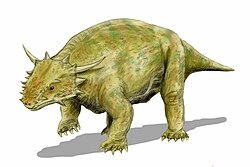| Owenettids Temporal range: Late Capitanian - Mid Carnian | |
|---|---|
 | |
| "Owenetta" kitchingorum | |
| Scientific classification | |
| Domain: | Eukaryota |
| Kingdom: | Animalia |
| Phylum: | Chordata |
| Clade: | † Parareptilia |
| Order: | † Procolophonomorpha |
| Superfamily: | † Procolophonoidea |
| Family: | † Owenettidae Broom, 1939 |
| Genera | |
Owenettidae is an extinct family of procolophonian parareptiles. Fossils have been found primarily from Africa and Madagascar, with one genus present from South America. It is the sister taxon to the family Procolophonidae. Modesto and Damiani (2007) defined Owenettidae as a stem-based group including Owenetta rubidgei and all species closely related to it than to Procolophon trigoniceps . [2] Maisch (2025) suggests that ichthyosaurs may have derived from owenettids, as they share numerous characteristics more closely than the previous neodiapsid hypothesis. [1]


